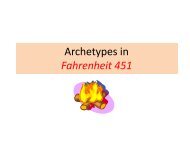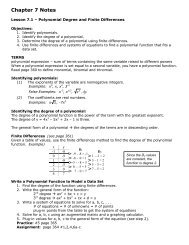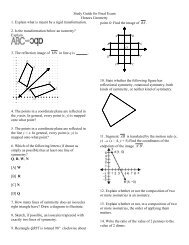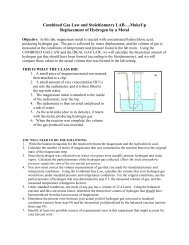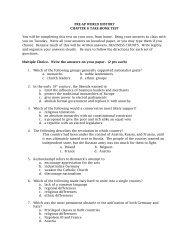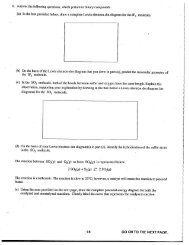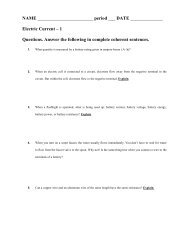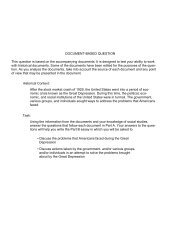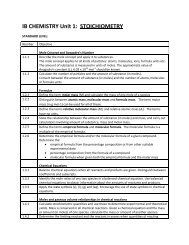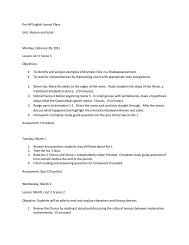You also want an ePaper? Increase the reach of your titles
YUMPU automatically turns print PDFs into web optimized ePapers that Google loves.
<strong>Macromolecules</strong><br />
Carbohydrates,Proteins,<br />
Lipids, and Nucleic Acids<br />
Chapter 2
• Carbon, hydrogen, oxygen, and nitrogen make up<br />
96% of living things. Sulfur and phosphorus are also<br />
important.<br />
• Organic compounds-compounds that contain carbon.<br />
-All organisms are organic.<br />
-Because Carbon has 4 valence electrons, it can<br />
form many types of molecules.
• <strong>Macromolecules</strong>-”giant” molecules<br />
• molecules with many carbon atoms joined<br />
together by polymerization-building a polymer.<br />
• monomer-single molecule that can combine<br />
with other monomers to form polymers<br />
-the order, number, and type of monomers<br />
combined, allows many types of polymers to be<br />
formed.<br />
• polymer-large molecule formed when many<br />
monomers bond together in various ways. Energy is<br />
stored in the bonds of polymers.<br />
Methane Acetylene Butadiene Benzene Isooctane
• condensation (dehydration synthesis)-when<br />
an –H and an –OH are removed from 2<br />
monomers to form a water (H 2<br />
O) molecule and<br />
build a polymer<br />
• hydrolysis-breaking apart a polymer by adding<br />
a water molecule. An -H and an -OH attach to<br />
the bonds between monomers in a polymer.<br />
-takes place in the digestion of<br />
food to break down polymers. The stored<br />
energy is released when these bonds are<br />
broken and is used to power daily functions.
1. Carbohydrates=Sugars<br />
•made of carbon, hydrogen, and oxygen in<br />
the proportion of 1:2:1<br />
-general formula is (CH 2<br />
O) n<br />
where n is the<br />
number of carbon atoms.<br />
-product of photosynthesis<br />
-store and transport energy in the bodies of living<br />
things<br />
-monosaccharides (monomer)-one sugar molecule<br />
(ex-glucose, galactose, and fructose)-quick<br />
energy<br />
-disaccharide-made of two sugar molecules<br />
(ex-sucrose or table sugar)
-polysaccharides-made of many sugar molecules. Larger<br />
so provide us with more energy than do other types of<br />
carbs.<br />
-examples<br />
1. starch-food storage product in plants<br />
2. glycogen-supplies the energy for muscle<br />
contraction in animals<br />
3. cellulose-forms the cells walls of plants and makes<br />
them rigid. Animals can’t digest cellulose but it is<br />
necessary in our diets for digestion and the elimination of<br />
waste. Known as fiber.<br />
4. chitin-forms cell wall of fungal cells and exoskeleton<br />
of arthropods
Polymer<br />
Starch<br />
Glucose<br />
Monomer
2. Lipids<br />
• made of carbon, hydrogen, and oxygen----have less<br />
oxygen than carbohydrates<br />
•Ex-fats, oils, waxes, cholesterol, and chlorophyll-molecule<br />
that collects sunlight for photosynthesis<br />
•Nonpolar so insoluble in water<br />
•used for long-term energy storage, metabolic reactions,<br />
insulation, and protective coatings (ex-plasma membrane)<br />
• triglyceride-most common type of lipid, consists of 3 fatty<br />
acids bonded to a molecule of glycerol<br />
-glycerol-a 3-carbon molecule that serves as a backbone<br />
for the lipid molecule
Glycerol<br />
3 Fatty acid chains
-saturated lipids vs. unsaturated lipids-<br />
-saturated lipids have carbon chains with single bonds of carbon<br />
and hydrogen atoms. They have the maximum number of these<br />
bonds and maximum amount of hydrogen (saturated with<br />
hydrogen). These are usually solid at room temperature (ex-butter<br />
and steak)<br />
-this is the “bad” fat. The more hydrogen a fat molecule<br />
has, the worse it is for your body<br />
-unsaturated lipids have carbon chains with double or triple bonds<br />
between carbon atoms. Fewer hydrogens can bond to carbon due to<br />
the double bonds.<br />
-since less hydrogen can bond here, these are better for you<br />
and are liquid at room temperature
3. Proteins<br />
•polymer of carbon, hydrogen, oxygen, nitrogen,<br />
and sometimes sulfur.<br />
-perform most functions in bodies of organisms and<br />
control the expression of traits<br />
-examples-enzymes, hair, muscles, spider's web,<br />
collagen fibers in skin, tendons, ligaments, and bones<br />
(support and structure…we don’t metabolize them for energy)<br />
-amino acids (monomer)-the basic building blocks<br />
of proteins. There are 20 amino acids.<br />
-more types of proteins than any other<br />
macromolecule because there are so many<br />
amino acids.
-peptide bond-bond formed between amino acids to<br />
make a protein<br />
-proteins are also called polypeptides because<br />
there are “many” of this type of bond in a protein<br />
-enzymes-proteins that act as a catalyst to speed up<br />
the rate of a chemical reaction. In some cases it<br />
allows some reactions to take place in a cell that<br />
normally would need very different conditions.<br />
Amino<br />
acids
4. Nucleic Acids<br />
-composed of carbon, hydrogen, oxygen, nitrogen, & phosphorus<br />
-macromolecule that stores hereditary information in a code that can be<br />
translated to form new proteins. Long chains of repeating monomers<br />
called nucleotides.<br />
-nucleotides-consist of a 5-carbon sugar with a phosphate group<br />
attached to one side of the sugar and a base attached to the other side.<br />
-DNA and RNA<br />
1. DNA is the genetic information---determines everything<br />
about an organism.<br />
2. DNA serves as the template for RNA. RNA is used to<br />
make proteins.



